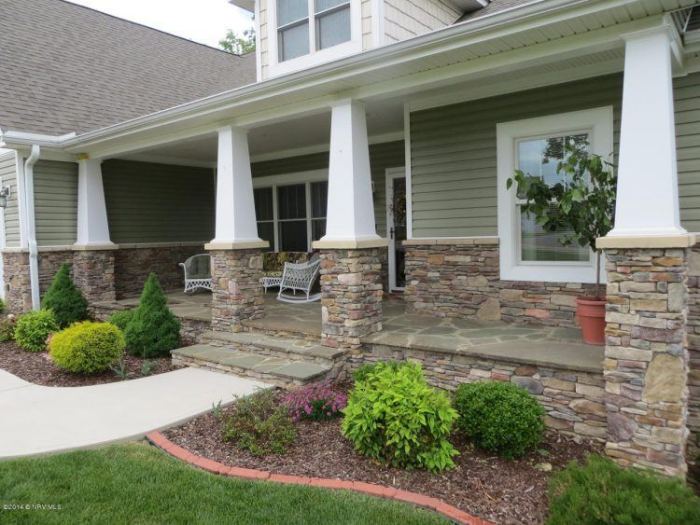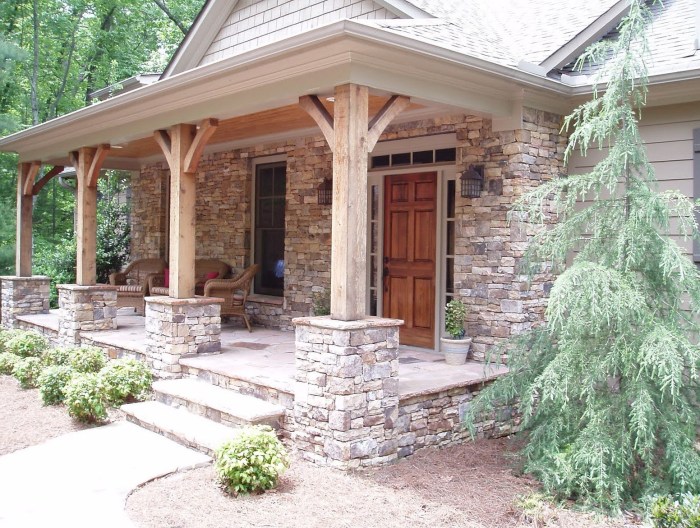The front porch is often the first impression visitors have of your home. It’s a space that should be both welcoming and stylish, and stone is an excellent material to achieve this. Stone front porches are durable, low-maintenance, and can be customized to complement any architectural style.
In this guide, we’ll explore the various elements of stone porch design, from choosing the right stone material to incorporating features and amenities that enhance its functionality and aesthetic appeal. We’ll also provide tips on landscaping and curb appeal, as well as a step-by-step guide to constructing and maintaining a stone front porch.
Stone Porch Design Elements
Stone porches offer a timeless and elegant addition to any home. They come in a wide range of materials, finishes, and styles, making them a versatile choice for any architectural design. Here’s a detailed look at the various stone materials commonly used in front porch designs, their pros and cons, and the different finishes available:
Stone Materials
- Granite: A highly durable and low-maintenance stone, granite is known for its strength, resistance to wear and tear, and wide range of colors and patterns. It is also relatively easy to clean and maintain.
- Limestone: A soft and porous stone, limestone is more susceptible to staining and damage than granite. However, it is also more affordable and comes in a variety of colors and textures, making it a popular choice for those looking for a more rustic look.
- Slate: A metamorphic stone, slate is known for its durability and resistance to water damage. It is also relatively easy to clean and maintain, and comes in a variety of colors and textures.
- Travertine: A porous and soft stone, travertine is more susceptible to staining and damage than other stones. However, it is also more affordable and comes in a variety of colors and textures, making it a popular choice for those looking for a more natural look.
- Bluestone: A sedimentary stone, bluestone is known for its durability and resistance to wear and tear. It is also relatively easy to clean and maintain, and comes in a variety of colors and textures.
Stone Finishes
- Honed: A smooth and matte finish, honed stone has a natural look and feel. It is less slippery than polished stone, making it a good choice for outdoor applications.
- Polished: A shiny and reflective finish, polished stone has a more formal and elegant look. It is more slippery than honed stone, so it may not be the best choice for outdoor applications.
- Tumbled: A rough and textured finish, tumbled stone has a more rustic and aged look. It is less slippery than honed or polished stone, making it a good choice for outdoor applications.
Porch Size and Shape
Determining the optimal size and shape of a front porch requires careful consideration of the house’s size and architectural style. The porch should complement the house, enhancing its overall aesthetic appeal while providing a functional and inviting outdoor space.
Size
As a general guideline, the porch should be proportionate to the size of the house. A larger house can accommodate a larger porch, while a smaller house may benefit from a more modest-sized porch. The porch should not overwhelm the house but should instead create a balanced and cohesive look.
Shape
Front porches come in various shapes, including rectangular, square, and L-shaped. Rectangular porches are the most common and offer a classic and versatile design that suits most house styles. Square porches provide a more symmetrical and formal look, while L-shaped porches offer additional space and flexibility, allowing for multiple seating areas or even an outdoor kitchen.
When choosing the shape of the porch, consider the architectural style of the house. For example, a traditional Victorian home may be best suited for a rectangular or square porch, while a modern or contemporary home may benefit from an L-shaped porch with clean lines and geometric angles.
Porch Features and Amenities
A stone front porch is not just a place to sit and relax; it can also be a stylish and functional extension of your home. There are many different features that you can incorporate into your stone porch design, such as columns, railings, and lighting.
By carefully choosing the right features, you can create a porch that perfectly complements the style of your house and enhances its functionality.
Columns
Columns are a classic way to add style and sophistication to a stone porch. They can be made from a variety of materials, including stone, brick, and wood. Columns can be used to support the roof of the porch, or they can be purely decorative.
If you are using columns to support the roof, it is important to make sure that they are strong enough to bear the weight of the structure. Decorative columns can be used to add visual interest to the porch and to create a sense of grandeur.
Railings
Railings are an important safety feature for any porch, but they can also be used to add style and personality to the space. Railings can be made from a variety of materials, including wood, metal, and glass. They can be simple or ornate, depending on your personal preferences.
When choosing railings for your stone porch, it is important to consider the style of the house and the overall design of the porch.
Lighting
Lighting is an essential element of any porch design. It can be used to create a warm and inviting atmosphere, and it can also help to improve safety. There are many different types of lighting fixtures that you can use on your stone porch, including wall-mounted lights, ceiling lights, and path lights.
When choosing lighting for your porch, it is important to consider the style of the house and the overall design of the porch.
Seating
No porch is complete without comfortable seating. There are many different types of seating that you can choose from, including chairs, benches, and swings. When choosing seating for your stone porch, it is important to consider the size of the porch and the number of people who will be using it.
You should also consider the style of the house and the overall design of the porch.
Storage
If you have a small porch, you may want to consider adding some storage space. This can be done by adding built-in cabinets or shelves. You can also use baskets or bins to store items such as blankets, pillows, and toys.
By adding storage space to your porch, you can keep it tidy and organized.
Other Amenities
There are many other amenities that you can add to your stone porch to make it more comfortable and enjoyable. These amenities can include a fire pit, a water feature, or a ceiling fan. By adding these amenities, you can create a space that you and your family will love to use.
Landscaping and Curb Appeal
Landscaping plays a crucial role in enhancing the curb appeal of a stone front porch. Well-chosen plants, flowers, and hardscaping elements can complement the stonework and create a welcoming atmosphere that invites guests inside.
Choosing Plants and Flowers
When selecting plants and flowers for a stone porch, consider their compatibility with the stone’s color and texture. Plants with soft, delicate foliage contrast beautifully with rough-hewn stone, while bold, architectural plants complement sleek, modern stonework. Choose flowers in colors that complement the stone, such as blues, purples, and yellows, to create a vibrant and inviting display.
Hardscaping Elements
Hardscaping elements, such as walkways, retaining walls, and steps, provide structure and functionality to the porch area. They can be constructed from materials that complement the stonework, such as brick, concrete, or natural stone. By incorporating these elements, you can create a cohesive outdoor space that seamlessly blends the porch with the surrounding landscape.
Construction and Maintenance
Constructing a stone front porch requires careful planning and execution. Here’s a step-by-step guide: Materials:
- Natural or cultured stone
- Concrete mix
- Rebar
- Gravel
- Sand
Tools:
- Shovel
- Wheelbarrow
- Trowel
- Level
- Measuring tape
- Circular saw
- Masonry chisel
Techniques:
- Excavate the area and lay a gravel base.
- Install rebar for reinforcement and pour a concrete footing.
- Build a stone foundation and walls using mortar.
- Create a waterproof membrane using tar paper or roofing felt.
- Lay the stone flooring and grout the joints.
Proper drainage is crucial to prevent water damage. Install downspouts to direct water away from the porch and slope the floor slightly towards the edge. Waterproofing is equally important. Apply a sealant to the stone to protect it from moisture and stains.Maintaining
a stone front porch involves regular cleaning, sealing, and repairs. Clean the porch with a mild detergent and water. Apply a sealant every few years to protect the stone from the elements. If cracks or damage occur, repair them promptly using matching stone and mortar.
Design Inspiration
Explore a gallery of captivating front porch designs that showcase the versatility and beauty of stonework. From classic to contemporary styles, these designs illustrate the endless possibilities of stone as a design element.
Each porch features unique characteristics, such as intricate stone patterns, contrasting textures, and innovative architectural details. Whether you prefer a traditional or modern aesthetic, you’re sure to find inspiration in this collection of stunning front porch designs.
Stonework Styles
- Traditional Stonework: Classic designs featuring natural stone materials like granite, limestone, or sandstone, often with rustic finishes.
- Contemporary Stonework: Modern designs that incorporate sleek stone materials like marble or quartz, with clean lines and minimalist aesthetics.
- Mixed Stonework: Designs that combine different stone materials and finishes to create unique textures and patterns.
Porch Designs
- Covered Porches: Stone-accented porches with roofs or awnings, providing shelter from the elements.
- Open Porches: Uncovered porches with stone flooring or pillars, offering a charming and inviting outdoor space.
- Raised Porches: Porches elevated from the ground level, creating a sense of grandeur and privacy.
- Wraparound Porches: Porches that extend around the sides of the house, providing ample outdoor living space.
Last Recap
Whether you’re looking to create a traditional or modern front porch, stone is a versatile material that offers endless possibilities. With careful planning and execution, you can create a stunning and inviting entrance that will welcome guests and enhance the curb appeal of your home for years to come.



